Course:FNH200/Projects/2023/Commercially Produced Jam vs Homemade Jam
This is a blank page for you to document and present your research project for FNH 200.
In addition to the traditional introduction, body of research, and references, don't forget to include a fact that you like your fellow students to know. Please present the fact in a format of Canvas quiz (multiple choice, multiple answers, fill in the blank, matching, etc), including the question, correct answers, distractors, as well as a quick explanation why your fellow students should know about this.
Your team reflection, one submission per team, should be submitted on Canvas.
How does the nutritional content of homemade jam differ from commercially produced jam?
Introduction/Product Info
Jam/jelly is a delightful and versatile food spread made mainly from fruits and sugar. It's known for its sweet and rich flavors, smooth textures, and vibrant colors. It has become a beloved addition to breakfast traditions worldwide, adding a burst of flavor and sweetness to morning treats like toast, bagels, English muffins, and pancakes. The magic of jam lies in its ability to preserve the natural goodness of fruits, capturing their peak flavors and allowing us to enjoy them long after their harvest season. The process involves cooking down fruits with sugar, resulting in a spreadable consistency that brightens up our breakfast table. Pectin, a natural component found in fruits, plays a role in jam-making, aiding in the gel-like texture and setting of the spread. There are many types of jam, as it comes in a delightful array of flavors, including classic strawberry, raspberry, blueberry, as well as branching out into more exotic flavors including mango, ginger, fig, peach, and many more. Since the flavor possibilities are endless, jam is a versatile and beloved food spread, typically adding a burst of vibrant taste and sweetness to many breakfasts!
History
The history of jam dates back to the Paleolithic period, approximately 2.6 million years ago, during the Stone Age. Early humans realized the importance of preserving food they collected during times of plenty to ensure survival during times of scarcity. This practice allowed them to avoid constantly searching for fresh food and provided sustenance during challenging periods. [1]
While the exact origins of fruit spread remain uncertain, it is believed to have ancient roots. Early civilizations engaged in sun-drying various foods as a method of preservation. However, recorded history suggests that the technique of jam-making began to emerge during the time of the Crusades. Soldiers returning from their journeys in the Middle East brought back the knowledge of preserving fruits in this manner. [2]
Until the 19th century, preserving foods was primarily a household activity, a tradition that persists in many homes to this day. The basic process of making jam involves dicing fruits and simmering them with sugar and pectin until a gel-like consistency forms. This technique allows the fruits' flavors and sweetness to be preserved, creating a delicious and long-lasting spread. [3]
One common preservation technique involved the use of honey or sugar. The Ancient Greeks, for example, utilized honey to preserve quince. Syrups derived from honey and sugar were also employed to preserve food, as honey's lack of moisture effectively preserved any food stored within it.[4]
Today, whether in the comfort of a home kitchen or within modern food processing facilities, the art of making jam remains consistent, bringing joy to breakfast tables worldwide with its delightful flavors and rich history.
Nutrition facts/information
Nutrition facts for jam can vary depending on the type of fruit used and the brand. After a quick internet search and trip to the grocery store, the general nutrition facts for 1 tablespoon of fruit jam is:
- Calories = 50-60 kcal
- Carbohydrates = 13-15g
- Sugars = 10-15g
- Fat = 0g (negligible amounts)
- Dietary Fiber = 0-1g
- Protein = 0-0.1g (negligible amounts)
Mass produced jams (i.e. famous brands) provide small amounts of vitamins, minerals, and antioxidants compared to homemade jams. Jam in general is high in added sugars, specially non-homemade jams. Jam is relatively high in sugar due to the fruit content and added sweeteners during preparation. It is recommended that you always read the ‘Nutrition Facts’ chart and compare different Jam brands and products before buying so you can make sure you are choosing a product that has a lower sugar content.
What does each ingredient contribute?
- Fruit = flavour and texture
- Sugar = helps sweeten the jam, interacts with pectin to create a gel-like structure, preservation, flavour enhancement, improve shelf stability
- Glucose = helps sweeten the jam, improves texture and smoothness, prevents crystallization, enhances shelf life, colour retention
- Pectin = gel formation (gives jam its semi-solid consistency), thickening agent, reduces cooking/preparation time, and improves shelf stability
- Citric acid = flavour enhancement, pH adjustment (reduces the pH level of jam), gel formation (helps activate pectin), preservation (by lowering the pH), and colour retention.
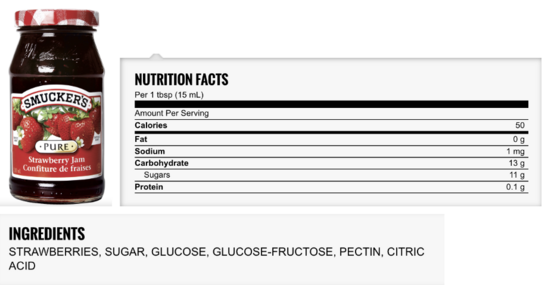

***We chose Smucker's because it is an international brand that has been around for decades and has a variety of flavours and products.
Production & Processing
Jams are produced commercially differently based on the scale of the business and regulations. “Vacuum process” is used in large scale commercial production of jams, while “open-kettle” is used in smaller scale productions. [5] The main difference between the two methods is that vacuum process preserves color and flavor better than the open-kettle method, but requires very expensive machinery. [5] This is because the vacuum process exposes the jam to lower temperatures for less time compared to the open-kettle process. [5] Regardless of method, the key steps in production and processing of jam remain similar:
Inspection:
Fruits that are selected for production of jam are inspected for colour, smell and appearance, ripeness, and taste. [6][7]
Cleaning:
Fruits enter the cleaning phase after passing inspection. Water is sprayed on the fruits to wash away any dirt that comes with the fruits to the factory/plant. The pressure of the water is not high to prevent damage to the fruits. [6][7]
Peeling and pulping:
Some fruits such as apples or citrus need to be peeled by hand or machines. Other fruits may need to have seeds and core removed by pulping machines.[7]
Addition of sugar, pectin, and acid:
In this part, sugar is added to the mixture. It serves as a great preservative as it can also bind free water and hinder potential microbial growth.[5][6][7][8] The aim is to have a final sugar content pf 65-69%. [5] Another component that is added is pectin, a naturally long chains of polysaccharide molecules inside fruits in varying amounts. [5][8] With sugar binding to free water, it also allows pectin molecules to bind to each other and creating the gel network that leads to the desired texture. [5][6] The amount of pectin and sugar is important, since too much of pectin will make the jam harder, and too much sugar will make the jam very sticky. [6] Pectin needs a slightly acidic environment to form gel networks. Citric acid or tartaric acid is sometimes added to bring the pH of the mixture to 2.8-3.3. [5][6][7]
Boiling:
Depending on the method used (vacuum process vs open kettle), the mixture is boiled either in open vessel under atmospheric pressure, or evaporated in a vacuum container which requires lower temperature (around 65-75 °C). [5] Boiling/evaporating the water leads to more concentrated mixture and reduces the amount of free water.[8] If vacuum process is used, pasteurization at temperatures of 85- 95 °C is needed to follow next due to the fact that the lower evaporation temperatures (around 65-75 °C) will not eliminate the microorganisms. [5]
Filling:
Jams are poured into presterilized cans/jars that are similar in temperature of recently boiled jams to prevent exposure of jams to significant temperature difference. The filled cans are then placed in water baths to cool them, while glass jars are cooled through air cooling tunnels. [5][6]
Different flavours/products
Jam comes in a wide variety of flavours and textures. The most popular and commonly found flavours include strawberry, blueberry, apricot, mixed berry, and raspberry.
Marmalade is a type of jam made from citrus fruits (e.g. oranges and lemons) and it contains both the fruit pulp and peel. Therefore it has a slightly bitter and tangy taste.
No-sugar-added jams are jams that have sugar substitutes (E.g. stevia and natural sweeteners) instead of sugar and glucose. This also allows the jam to have less calories.
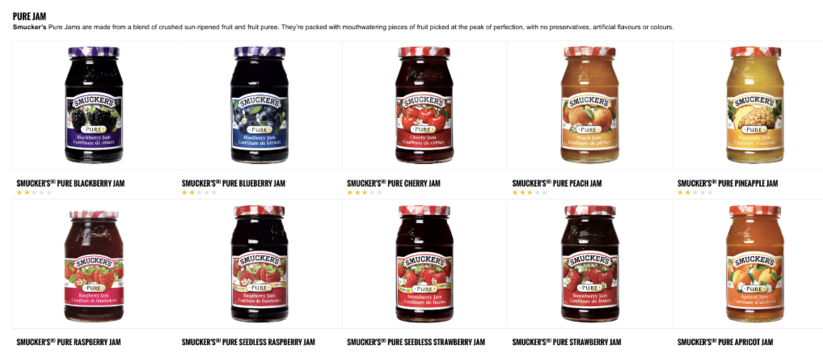
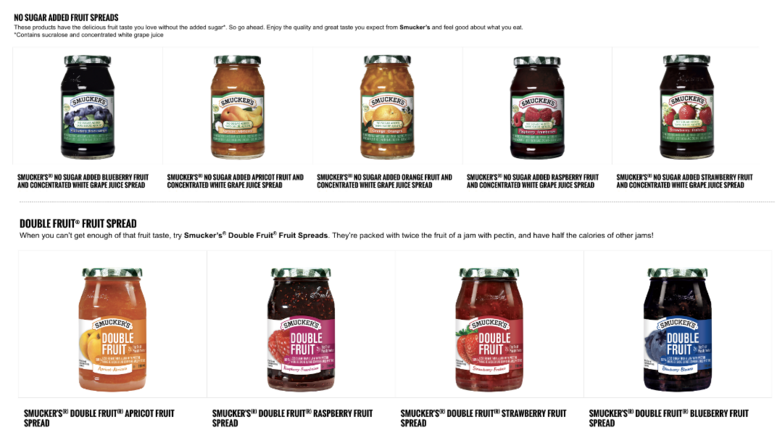
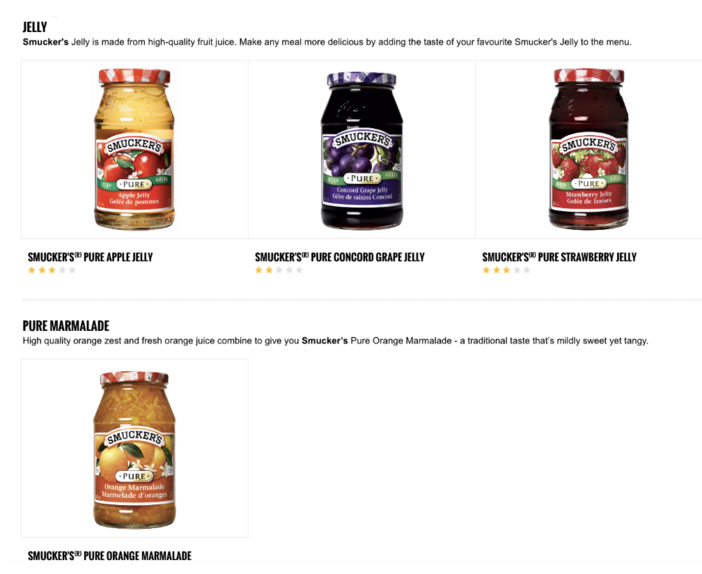
Regulations in Canada
There are government standards and regulations in place for jams sold in Canada to ensure the quality of products available to consumers. The same standards apply to jam products whether they are made in Canada or they are imported. The Department of Justice of Canada is responsible for maintaining the Food and Drugs Act. The Health products and Foods Branch of Health Canada administers the Food and Drugs Act; while the Canadian Food Inspection Agency inspects and enforces these food regulations and is responsible for accurate food labels.[10]
There are standards regarding the composition and identity of jam products identified within the Food and Drugs Act. Taken directly from Section 11, Division B.11.201 [S] of the Canadian Food and Drugs regulation, Fruit jams:[11]
- (a) shall be the product obtained by processing fruit, fruit pulp, or canned fruit, by boiling to a suitable consistency with water and a sweetening ingredient;
- (b) shall contain not less than
- (i) 45% of the named fruit, and
- (ii) 66% water soluble solids as estimated by the refractometer;
- (c) may contain
- (i) such amount of added pectin, pectinous preparation, or acid ingredient as reasonably compensates for any deficiency in the natural pectin content or acidity of the named fruit,
- (ii) a Class II preservative,
- (iii) a pH adjusting agent, and
- (iv) an antifoaming agent; and
- (d) shall not contain apple or rhubarb.
On the other hand, taken directly from Section 11, Division B.11.202 [S], fruit jams with pectin:[12]
- shall be the product obtained by processing fruit, fruit pulp, or canned fruit by boiling to a suitable consistency with water and a sweetening ingredient;
- shall contain
- not less than 27% of the named fruit,
- not less than 66% water soluble solids as estimated by the refractometer, and
- pectin or pectinous preparations;
- may contain
- such amount of acid ingredient as reasonably compensates for any deficiency in the natural acidity of the named fruit,
- food colour,
- a Class II preservative,
- a pH adjusting agent, and
- an antifoaming agent; and
- Must not be made by processing fruit pulp that is preserved in sulphur dioxide.
- shall not contain apple or rhubarb.
Apple and rhubarb jams have different standards of regulation when it comes to composition. Taken directly from Section 11, Division B.11.203 [S], Apple and rhubarb mixed with another fruit Jams:[12]
- a) shall be the product obtained by processing fruit, fruit pulp or canned fruit by boiling to a suitable consistency with water and a sweetening ingredient;
- (b) shall contain not less than
- (i) 12.5% of the added extra fruit, except that where the fruit is strawberry, it shall contain not less than 15 per cent strawberries,
- (ii) 20% apple or rhubarb pulp, and
- (iii) 66% water soluble solids as estimated by the refractometer; and
- (c) may contain
- (i) pectin or pectinous preparation,
- (ii) such amount of acid ingredient as reasonably compensates for any deficiency in the natural acidity of the fruit used in its preparation,
- (iii) food colour,
- (iv) a Class II preservative,
- (v) a pH adjusting agent, and
- (vi) an antifoaming agent.
For labelling requirements, jams sold in Canada are subject to the labelling requirements under the Food and Drugs Act (FDA) and Food and Drugs Regulations (FDR), as well as specific requirements of the Safe for Canadians Act (SFCA) and Safe for Canadians Regulations (SFCR)[13]. These regulations state that the labels for the products must include:
- The common name of the product (e.g. “Name of fruit” jam) appearing on the principal display panel of the product.
- Net quantity of the product declared on the principal panel of display.
- Container sizes (This applies to products traded inter-provincially; the net quantity of the product should match that defined in the Standard container Sizes document.)[14]
- “Keep refrigerated after opening” if the jam is required to be refrigerated after opening. Marking must be clearly and prominently shown on the label.
- Name and Principal place of business indicated on label
- Country of origin declared clearly on the package
- Grade name for processed fruit products[15] which are listed in volume 3[16] of the compendium
- Lot code along (unique identifier on package for traceability purposes) declared on package
- Nutrition facts table must be indications of composition of the product per serving
- Clear ingredient list must be on the principal label
- Best before or expiry date must be declared on package
- Voluntary claims and statements (e.g. health statements)
Jam products must also abide by the Standards for processed fruit and vegetable products that state that at least 90% of the volume capacity of the package must be filled with the product[15]. For non-frozen processed fruit and vegetable products such as jams, the product must be filled with as much product as the preparation allows and must not contain amounts of syrup, brine, water and added liquid packaging mediums more than what is just what is required by processing of the product. As an example, if additional syrup or sweetened water is added to the jam for taste, it should be clearly and prominently indicated on the package as “Extra Heavy/Heavy syrup”.[15]
Furthermore, all additives added to jam products must be named and detailed and submitted as an application to Health Canada. The application should specify the name of the additive, its purpose, quantity added, and maximum limit of residual additive in the final product. The manufacturer must also include detailed reporting of tests conducted to ensure the safety of the jam product. Health Canada with the help of outside experts then weighs the risks vs benefits of the product and then accepts or rejects the application.[10]
Overall, all jam products available for sale must abide by the FDA, FDR, SFCR, SFCA regulations. These regulations ensure a standard of identity and composition of the product and ensure that the jam products are safe for consumers.
Homemade Jam Recipe[17]
Ingredients for simple jam recipe:
1kg Fruit
1kg Granulated sugar
Optional: Lemon juice (depending on the fruit you use)
Optional: Pectin (depending on the fruit you use)
- Step 1: choosing the fruit and the pan
Jam making process involves equal parts of your fruit of choice and sugar. As mentioned in previous sections, there are many fruit options that can be used, however seasonal fruits are preferred for optimal flavor. While picking the fruit, its best to use slightly unripe or just ripe ones as they contain more pectin and acidity which helps with the jam texture.
After washing the fruit, start by heating up the fruit in a low-sided wide stainless steel saucepan on the stove using low heat. Avoid using aluminum pans as the acidity in the fruits can react with it and change the taste.
Some fruits have naturally high amounts of pectin, e.g. apples and plums, however if the recipe needs more pectin, commercially sold pectin can be added or mixing high pectin fruits with low pectin fruits.
Pectin is the jelling substance in fruits. There is a high amount of pectin in pops, cores and skin of fruits. Unripe fruits contain pectose in their cell walls, which is the insoluble substance that converts into pectin as the fruits ripens.
- Step 2: Heating up the fruit
As the fruit is warming up on low heat settings, do not add any sugar as it will draw moisture and water out of the fruit via osmosis and change the shape of the fruit. Add small amount of lemon juice to the mixture. This will increase the acidity and help the pectin forming branches and hold moisture.
- Step 3: Heating up the sugar
Adding sugar and a small amount of lemon juice to the mixture will help the pectin chains to form a network and increase their water holding capacity. Adding heated sugar will result in a more flavorful jam.

Heat granulated sugar in a stainless-steel bowl on moderate heat for about 15 minutes. Avoid stirring, and also do not leave the sugar on the stove for too long, as it can caramelize and disrupt the jam taste.
- Step 4: and adding it to the fruit mixture
Add the sugar to the fruit mixture when the fruit has thoroughly softened using low heat. Slowly stir the mixture and observe the thickening effect of sugar. A foam layer may be formed on the surface, remove that using a spoon. After 5-20 minutes, the pectin network has fully formed. Double check that the jam has reached the setting point by using a jam thermometer. When the thermometer shows 105ºC (220ºF), the jam is set.
- Step 5: Transfer into glass jars
After removing the pot from the stove, allow the jam to thicken up even more and cool for about 10 minutes. Pour the jam into sterilized jars (previously washed with hot water and soap and thoroughly dried in the oven at 160 ºC) and cover them with a lid. To prevent mold growing on the surface, using jars with sterilized lids that have three components of a silicone disc of paper, a large round of cellophane and a rubber band is recommended.
- Step 6: Storage
Store In A Cool, Dark Place. No need to store the jam in a fridge if the jars and the lids were sterilized beforehand, however to make sure of preserving the jam and minimize the chances of deterioration, homemade jams can be stored in the fridge for up to three weeks or served and enjoyed immediately after preparation.
Low calorie options and modified nutritional facts
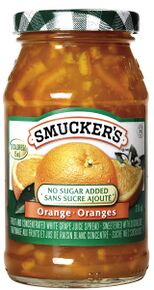
Assessing Smucker’s no sugar added orange jam:
INGREDIENTS:
RECONSTITUTED ORANGE JUICE AND PEELS, CONCENTRATED WHITE GRAPE JUICE, WATER, PECTIN, CITRIC ACID, GUAR GUM, POTASSIUM SORBATE, CALCIUM CHLORIDE, SUCRALOSE, NATURAL FLAVOUR, COLOUR, 8mg OF SUCRALOSE PER 15 mL SERVING[19]
- Even though this product is marketed as “ no sugar added”, it still contains sugar that is within the ingredients such as orange juice and white grape juice.
- Sucralose (brand name Splenda) is an artificial sweetener that is used as a sugar substitute. Sucralose is a chlorinated molecule in which 3 hydroxyl groups(OH) of the sucrose molecule are replaced by chlorine. It tastes similar to sugar but it is 600 times sweeter than sucrose. Sucralose is not metabolized by the human body, passing through unchanged (contributes to 0 Cal/g). It does not increase blood glucose or insulin levels and also does not promote the growth of oral bacteria [20]
- Due to the lack of “added sugar” which is the main thickening agent in jams, calcium chloride is added to the ingredients. Its main purpose is to thicken up the jam and make it firm. Because of the low/no amount of added sugar, the risk of the fruit setting improperly increases therefore it is essential to add calcium chloride to promote firmer texture in jams by strengthening the pectin in the fruit mixture and helping the gel formation. Another thickening agent that has been added is the guar gum, which helps with stabilizing the jam and its setting process. [21]
- The “added sugar” also helped in preservation of the jam. In “no sugar added” sugar jams, there needs to be more preservatives added. Potassium Sorbate is an example of added preservative, which extends the shelf life by preventing the spoilage of jam by bacteria, mold and yeast. This preservative also allows for the jam to be stored at room temperature up until opening.
Summary
Jam products in Canada are a staple food product in most households. With its various flavours and its long shelf life, it allows for various preparations of meals and snacks. Jam products are made by cooking fruits, sugars and sometimes pectin to create a gel-like consistency. Jams can be bought from grocery stores or can be made at home in various flavours such as blueberry, strawberry, apple, rhubarb, etc.
There are various regulations and standards in place to ensure that commercially produced jam products are safe for Canadians to consume. While Health Canada administers the Food and Drugs Act and is also responsible for approval of additives, The Canadian Food Inspection Agency is responsible for enforcing these regulations and the accurate labelling of food products. The products sold in Canada must abide by various regulations and standards to ensure the safety of the products for the consumers. These regulations and standards vary depending on the type of fruit used to make the jams.
Nutrition facts for 1 tablespoon of fruit jam can vary depending on the type of fruit used and the brand. On average, 1 tablespoon of commercially produced jam contains around 50-60 kcal, 13-15g of carbohydrates, but negligible amounts of fat and protein between 0-0.1g. Homemade jams generally offer higher amounts of vitamins, minerals, and antioxidants compared to mass-produced jams from famous brands. Making homemade jams allow for consumers to use fresh and high-quality ingredients that they choose, be in control of how much sugar is used, and contain less preservatives/additives. Moreover, homemade jams generally undergo less heat exposure which allows for less nutrient degradation.
Overall, both homemade jams and commercially-produced jams come in various flavours, are low in fat, and make for a great food product to give consumers an energy boost. Making jams at home allows for the customization of the ingredients and the less processing and heat exposure allow for the retention of nutrients that would otherwise degrade during the mass production of jams.
Exam Question
Q: What function does pectin have in jam making?
a. Act as a natural preservative
b. Enhance gel formation
c. Flavouring agent, increase sweetness
d. Colouring agent
Answer: Option B
Explanation as to why it should be on the exam:
Throughout this course, we were familiarized with the important properties of pectin, which leads to gel formation that is crucial in making jellies and jams. Pectin is naturally occurring carbohydrate in fruits, and while making jams, it is important to note if the fruit is high in pectin naturally or needs extra pectin to form the desired texture. Our project focused on role of pectin, therefore it is going to be a well thought-out question on the exam.
References
https://blog.thenibble.com/2017/04/03/food-101-the-history-of-jam-jelly-preserves/[22]
https://www.encyclopedia.com/manufacturing/news-wires-white-papers-and-books/jam-and-jelly[23]
https://www.freshways.co.uk/a-history-of-jam-and-preserves/[24]
Chan, Judy, FNH 200Lesson 4[10]
https://laws-lois.justice.gc.ca/eng/regulations/c.r.c.,_c._870/page-36.html#h-572428[11]
https://laws-lois.justice.gc.ca/eng/regulations/c.r.c.,_c._870/page-37.html[12]
https://inspection.canada.ca/food-labels/labelling/industry/processed-fruit-or-vegetable-products/eng/1631562544919/1631562709087[13]
https://inspection.canada.ca/about-cfia/acts-and-regulations/list-of-acts-and-regulations/documents-incorporated-by-reference/standard-container-sizes/eng/1630012816407/1630012816907[14]
https://inspection.canada.ca/food-labels/labelling/industry/processed-fruit-or-vegetable-products/eng/1631562544919/1631562709087#s4c14[15]
https://inspection.canada.ca/about-cfia/acts-and-regulations/list-of-acts-and-regulations/documents-incorporated-by-reference/canadian-grade-compendium-volume-3/eng/1522257117725/1522257118286?chap=0[16]
- ↑ "SMUCKER'S® PURE STRAWBERRY JAM".
- ↑ "SMUCKER'S® PURE RASPBERRY JAM".
- ↑ "SMUCKER'S® PURE APRICOT JAM".
- ↑ "Image".
- ↑ 5.00 5.01 5.02 5.03 5.04 5.05 5.06 5.07 5.08 5.09 5.10 "Fruit jam processing – What do you need for jam setting besides sugar, acid & pectin?".
- ↑ 6.0 6.1 6.2 6.3 6.4 6.5 6.6 "Mixed Fruit Jam Production".
- ↑ 7.0 7.1 7.2 7.3 7.4 "Jam and Jelly".
- ↑ 8.0 8.1 8.2 "The Science of Making Jam (Fruit Jelly)".
- ↑ "SMUCKERS JAMS, JELLIES AND FRUIT SPREADS".
- ↑ 10.0 10.1 10.2 Chan. Judy (2023) FNH 200 Lesson 4. Access from Course:FNH200/Lessons/Lesson 04 [Accessed 6 Aug. 2023].
- ↑ 11.0 11.1 Legislative Services branch. "Food and Drug Regulations DIVISION 11 Fruits, Vegetables, Their Products and Substitutes". Retrieved August 3, 2023. line feed character in
|title=at position 38 (help) - ↑ 12.0 12.1 12.2 "Food and Drug Regulations DIVISION 11 Fruits, Vegetables, Their Products and Substitutes". Legislative Services Branch, Justice Laws. Retrieved August 3, 2023. line feed character in
|title=at position 38 (help) - ↑ 13.0 13.1 "Labelling requirements for processed fruit or vegetable products". Government of Canada, Inspection Canada. Retrieved July 30, 2023.
- ↑ 14.0 14.1 "Standard Container Sizes". Government of Canada, Safe food for Canadians regulations document. Retrieved Aug 1, 2023.
- ↑ 15.0 15.1 15.2 15.3 "Labelling requirements for processed fruit or vegetable products". Inspection Canada. Retrieved Aug 1, 2023.
- ↑ 16.0 16.1 "Canadian Grade Compendium: Volume 3 – Processed Fruit or Vegetable Products". Government of Canada. Retrieved August 1, 2023.
- ↑ Connelly, Andy (3 Oct, 2013). "The science and magic of jam-making". The Guardian. Check date values in:
|date=(help) - ↑ Allen, Darina (10 Mar, 2010). "How to Make Jam". The Guardian. Check date values in:
|date=(help) - ↑ Smuckers Orange Jam, Low calorie. "SMUCKER'S® NO SUGAR ADDED ORANGE FRUIT AND CONCENTRATED WHITE GRAPE JUICE SPREAD". Check date values in:
|archive-date=(help) - ↑ Chan, Judy (Aug 5, 2023). "FNH 200 Lesson 3". UBC wiki.
- ↑ Chan, Judy (5 Aug, 2023). "FNH 200 Lesson 4". UBC wiki. Check date values in:
|date=(help) - ↑ The Nibble Blog (April 3, 2017). "History of Jam, Jelly, & Preserves". The Nibble. Retrieved July 30, 2023.
- ↑ "Jam and Jelly". Encyclopedia.com. July 26, 2023.
- ↑ "A History of Jam and Preserves". Freshways. January 4, 2021. Retrieved July 30, 2023.

